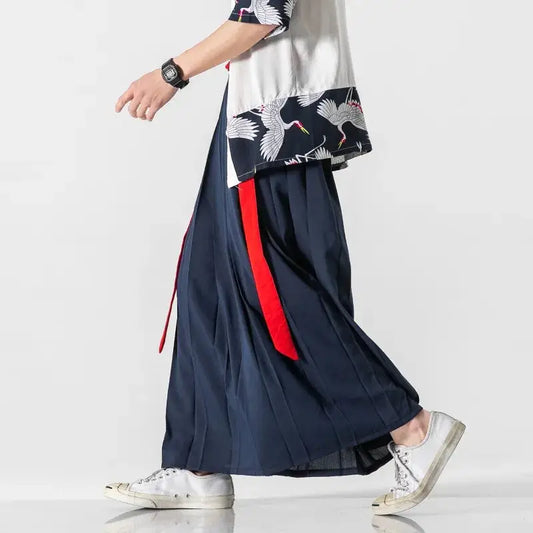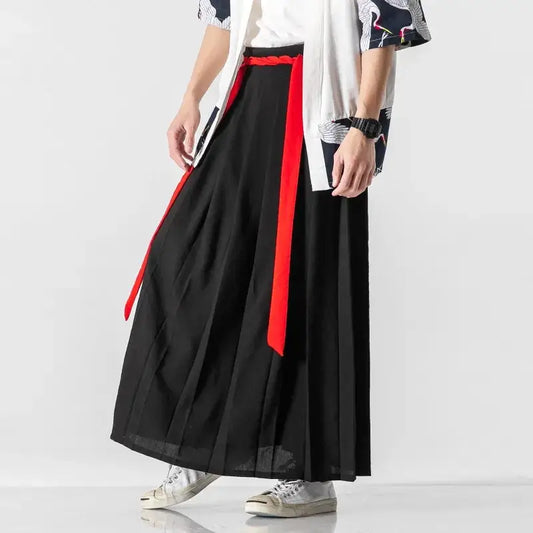Step into Elegance: Discover the Timeless Power of Hakama
Grace, heritage, and dignity woven into every pleat — welcome to the world of Hakama, Japan’s iconic wide-legged trousers that blend fluidity, symbolism, and strength. Whether you're familiar with their samurai legacy or you’re just discovering them through modern cosplay or cultural events, Hakama are more than just clothing. They are movement, meaning, and tradition brought to life.
Worn by martial artists, priests, students, and brides, Hakama hold a unique space in Japanese attire. At once stately and versatile, they elevate the silhouette, add a sense of ceremony, and embody centuries of cultural depth. Whether tied over a kimono or adapted into contemporary fashion, the Hakama is a powerful statement of identity and style. In this in-depth guide, we celebrate this legendary garment with history, styling inspiration, practical pairing, and more.
From Feudal Roots to Modern Runways: A Brief History of Hakama
Hakama date back to the Heian period (794–1185), when they were worn by Japanese nobility to signify class and decorum. In the centuries that followed, samurai warriors adopted Hakama as part of their official attire, adding functionality to its elegance. The wide pleats allowed movement on horseback, while the structured design exuded discipline and respect. Hakama became a standard in martial arts such as Kendo, Aikido, Iaido, and Kyudo, further solidifying its ties to honor and mastery.
| Era | Role of Hakama | Symbolism |
|---|---|---|
| Heian | Noble attire for court | Class, status, and aesthetics |
| Edo | Samurai uniform | Discipline, skill, bushido spirit |
| Meiji-Taisho | Academic dress | Intellect, modernity, formality |
| Modern Day | Martial arts, weddings, fashion | Tradition meets personal expression |
Today, Hakama are worn in Shinto ceremonies, graduation events, weddings, and increasingly in high fashion and streetwear. Whether it’s a silk Hakama adorned for a shrine maiden or a street-styled version with sneakers and a cropped jacket, its appeal remains potent across generations and cultures.
Why Hakama is a Wardrobe Masterpiece
Hakama may appear simple at a glance, but their depth of design and function make them one of the most compelling garments in traditional fashion. Here's why they deserve a space in your closet:
Movement and Grace: The flowing pleats provide an unmatched sense of elegance. Whether walking, kneeling, or striking a pose, Hakama enhance body language and poise.
Structured Symbolism: Traditional Hakama feature seven pleats — five in front, two in back — each representing virtues like loyalty, courage, and honor.
Gender Fluidity: While rooted in masculine attire, Hakama have always been worn by women too. Modern Hakama effortlessly transcend gender, making them ideal for diverse expressions of style.
Comfort and Function: Designed to sit high on the waist and flow outward, Hakama offer breathability, range of motion, and adjustable fit with ties (“himo”).
Versatility: Available in fabrics from crisp cotton to elegant silk, they can be styled for ceremonial formality or laid-back modern aesthetics.
Hakama blend fashion with philosophy, offering not just style but substance. You don’t just wear Hakama — you embody a story of purpose, posture, and power.
Styling Hakama: Where Heritage Meets High Fashion
The beauty of Hakama lies in their adaptability. Whether traditional or experimental, these wide-legged marvels create striking silhouettes that command attention.
| Style Vibe | Outfit Idea | Footwear | Occasion |
| Traditional Elegance | Hakama + Kimono top + Obi belt | Zori sandals | Weddings, ceremonies |
| Street Chic | Hakama + graphic tee + bomber jacket | Chunky sneakers | Everyday, fashion shoots |
| Academic Vintage | Hakama + high-neck blouse + haori | Leather oxfords | Graduation, events |
| Minimal Modern | Monochrome Hakama + oversized shirt | Loafers or barefoot | Artistic settings |
| Gender-Neutral Couture | Hakama + asymmetrical tunic | Platform boots | Fashion shows |
Pro styling tips:
-
Add layered necklaces or ear cuffs to contrast the traditional lines.
-
Choose a cropped jacket or haori to highlight the pleats.
-
Play with contrasting textures — matte Hakama with satin tops, or raw cotton with leather.
Perfect Pairings: Accessories and Complements for Hakama Outfits
To truly let your Hakama shine, coordinate with carefully chosen accessories and complements. Done right, it takes the ensemble from simply interesting to unforgettable.
| Item | Why It Works |
| Haori Jacket | Balances the wide legs with structured shoulders |
| Obi Belt | Highlights the waist and adds color or contrast |
| Tabi Socks | Perfect under traditional sandals or even modern loafers |
| Kanzashi Hair Pins | Traditional touch for formal occasions |
| Fanny Pack or Waist Bag | Adds edge to street-style Hakama |
| Kimono Underlayer | Creates a tiered, layered look with elegance |
Try to balance volume — if your Hakama are voluminous, go sleek on top. If your top half has structure or statement, keep your Hakama subdued in color. The silhouette game is everything when it comes to Hakama.
Hakama is More Than Fashion — It’s Philosophy
Hakama are more than trousers. They are a canvas of identity, heritage, and strength. In each pleat is a tribute to a code of conduct. In each fold, the flow of history meets the breeze of modernity. When you wear Hakama, you do more than dress up — you channel dignity, presence, and poise.
Whether for a performance, a photoshoot, a wedding, or your daily self-expression, Hakama are a powerful addition to any wardrobe. They are bold, yet grounded. Fluid, yet firm. A statement of both independence and deep cultural respect.
Wear them with intention. Walk with purpose. Let the rhythm of tradition guide your steps.
Welcome to the Hakama lifestyle — where every fold has a purpose and every step is a story





